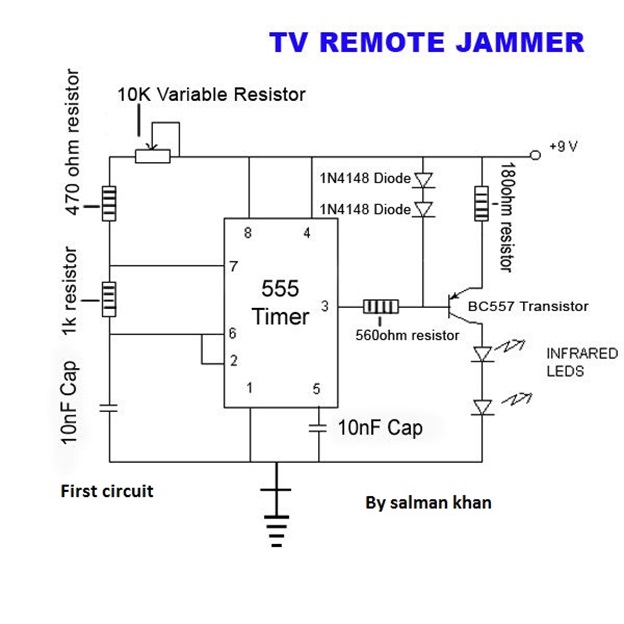What is jammer?
A machine which locks a machine into an unworkable position
What is TV jammer?
A machine or a remote which block the further working of the TV original remote is what we know as TV jammer.
This TV remote control jammer circuit confuses the infra-red receiver in a TV. It produces a constant signal that interferes with the signal from a remote control and prevents the TV detecting a channel-change or any other command. This allows you to watch your own program without anyone changing the channel!! The circuit is adjusted to produce a 38 kHz signal. The IR diode is called an Infra-red transmitting Diode or IR emitter diode to distinguish it from a receiving diode, called an IR receiver or IR receiving diode. (A Photo diode is a receiving diode). There are so many IR emitters that we cannot put a generic number on the circuit to represent the type of diode. Some types include: CY85G, LD271, CQY37N (45¢), INF3850, INF3880, INF3940 (30¢). The current through the IR LED is limited to 100mA by the inclusion of the two 1N4148 diodes, as these forms a constant-current arrangement when combined with the transistor and 5R6 resistor.
Experiment: 1
The items you should have to make first circuit:
1. Small circuit board
2. (1) 10k variable resistor
3. (1) 555 Timer
4. (4) Resistors. 470ohm, 1k, 560ohm
5. (2) High speed switching diodes 1N4148
6. (1) Transistor – BC557
7. (2) Infrared LED’s
8. (2) 10nf capacitors
9. (1) 9 volt battery
This is the circuit diagram by which you can be able to make the first circuit. I think that you can make it by your own by seeing the image. Don’t worry anything you made if produce stable non detected waves will stop the TV to work as it could not find the data or signal that you have send by you. If you want to change the value of resister you can change as you only have to send the undetected waves. The binary code wave which is not in the list of the TV is undetected wave. We have one advantage is that the TV remote signal is in the high range of giga hertz.
Advantages of the first circuit:
1. It will not affect the signal receiving capacity of the TV.
2. This circuit is used in the family where we have to see a particular channel or scene, so few of them pause the TV by this and then they watch the channel very happily and then restart the TV to make the TV work as it was working.
3. Can go to some bodies house and then change
Disadvantages of the first circuit:
1. It is costly than the second circuit.
2. Heavy compound is required.
3. Only knowledgeable person can make this.
4. More current consumption than the second circuit.
There’s a new weapon in the war for television supremacy, and with a range of 400 feet, the Ninja Remote promises to confuse, befuddle, and enrage TV junkies from a safe distance that won’t get you immediately beat up.
The remote is programmed to automatically work with nearly all TVs on the market, blasting an array of codes every time you press the power, volume, and channel buttons. And while the extended range is handy for pranksters who’d like to remain anonymous, the high-powered IR emitters can also jam and prevent other remotes from working, giving you all the power.
In addition to standard TV functions, the $30 Ninja Remote also has a bomb function that will cause a TV to randomly change channels and volume levels for 5 to 15 minutes, driving viewers particularly mad. But it means you can hide it somewhere and leave the room while it wreaks havoc, giving you an alibi that it couldn’t possibly be your doing.
But saving the best for last, the remote is also now programmed to trigger the shutter on 99 percent of the digital cameras on the market. Letting you snap random pointless shots on other people’s cameras. So before these things become popular again, I recommend breaking out the black electrical tape and covering your camera’s IR sensor.
Circuit Diagrams
Filed Under: Electronic Projects



Questions related to this article?
👉Ask and discuss on Electro-Tech-Online.com and EDAboard.com forums.
Tell Us What You Think!!
You must be logged in to post a comment.